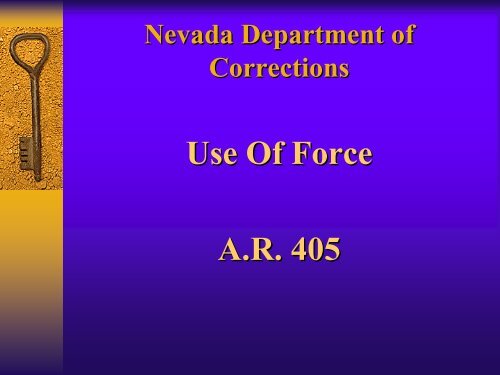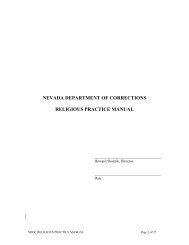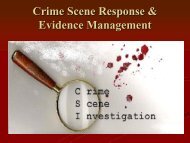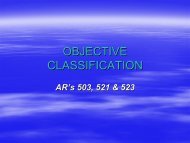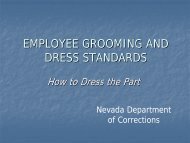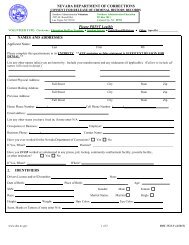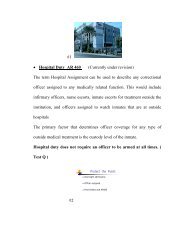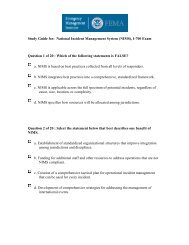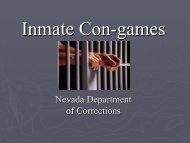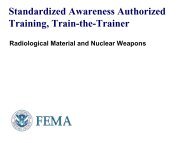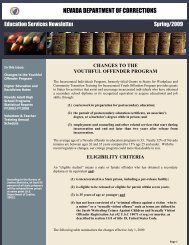Elements of Deadly Force - Nevada Department of Corrections
Elements of Deadly Force - Nevada Department of Corrections
Elements of Deadly Force - Nevada Department of Corrections
Create successful ePaper yourself
Turn your PDF publications into a flip-book with our unique Google optimized e-Paper software.
<strong>Nevada</strong> <strong>Department</strong> <strong>of</strong><strong>Corrections</strong>Use Of <strong>Force</strong>A.R. 405
What is <strong>Force</strong>?♦ <strong>Force</strong> - Any violence, compulsion, or constraintphysically exerted by any means upon or against aperson♦ <strong>Deadly</strong> <strong>Force</strong> – Any force that carries asubstantial risk that will possibly result in death <strong>of</strong>a person♦ Excessive <strong>Force</strong> – Any act <strong>of</strong> force in excess <strong>of</strong>what it takes to subdue a resisting inmate and/or tomove a resisting inmate to a secure location
When <strong>Force</strong> May Be Used♦ To protect the safety <strong>of</strong> oneself or others fromharm♦ To prevent escape♦ To prevent destruction <strong>of</strong> state property♦ To compel compliance with lawful orders♦ To prevent or quell a disturbance
Liability♦ 8 th Amendment–Cruel and unusualpunishment♦ Civil Rights Action is filed when lawenforcement personnel act or do somethingunder color <strong>of</strong> law that deprives anyone <strong>of</strong> theirconstitutional rights or subject or causes one tobe subjected to a wrong.
Liability♦ Violation <strong>of</strong> criminal code – not only can youface tort suit or civil rights suit, you can also becriminally charged as a law enforcement <strong>of</strong>ficer♦ Good faith is an effective defense.♦ Graham vs Conner: <strong>Force</strong> must be reasonablebased on the totality <strong>of</strong> circumstances
<strong>Nevada</strong> Law♦ In keeping with the policy <strong>of</strong> the<strong>Department</strong> <strong>of</strong> <strong>Corrections</strong>prohibiting the use <strong>of</strong> excessiveforce, NRS 212.020 – “Inhumanityto Prisoners,” is noted as follows:
a. Every jailer or person who shall be guilty <strong>of</strong>willful inhumanity or oppression to any prisonerunder his care or custody shall be punished:1) Where the prisoner suffers substantial bodily harm forsuch inhumanity or oppression, by imprisonment in thestate Prison for not less than one year nor more than sixyears or by a fine <strong>of</strong> not more than $5,000.00 or bothfine and imprisonment2) Where no substantial bodily harm results, a grossmisdemeanor.b. Whether or not the prisoner suffers substantialbodily harm, any public <strong>of</strong>ficer guilty <strong>of</strong> suchwillful inhumanity is guilty <strong>of</strong> a maleficence <strong>of</strong><strong>of</strong>fice.
<strong>Elements</strong> <strong>of</strong> <strong>Deadly</strong> <strong>Force</strong>♦Ability or apparent ability♦Opportunity♦Imminent jeopardy♦Preclusion
Ability or Apparent Ability♦Does Does the violator/inmate possessthe ability or the apparent ability tokill you or a third party, or to causeyou or a third party great bodilyharm?
Opportunity♦Does Does the violator/inmate have theopportunity to kill you or a thirdparty, or cause you or a third partygreat bodily harm?
Imminent Jeopardy♦Has Has the violator/inmate placed youor a third party in imminentjeopardy
Preclusion♦Have Have you reasonably exhausted all<strong>of</strong> your avenues <strong>of</strong> retreat at thattime and at that place? Was therethe feasibility or availability <strong>of</strong>alternative actions?
Factors Considered whenReviewing Use <strong>of</strong> <strong>Force</strong>♦ Was it applied in good faith♦ Extent <strong>of</strong> the threat to the safety <strong>of</strong> staff andinmates♦ Need for application <strong>of</strong> force♦ Relationship between the need and the amount<strong>of</strong> force used♦ Extent <strong>of</strong> injury inflicted
Confrontational ContinuumOfficer-Subject FactorsAgeSexSizeSkill LevelMultiple OfficersMultiple SubjectsRelative StrengthSpecial CircumstancesClose Proximity to FirearmSpecial KnowledgeSpecial abilityInjury or exhaustionGroundDisabilityImminent DangerDistance from subjectAvailability <strong>of</strong> otheroptions
Use <strong>of</strong> <strong>Force</strong> Continuum♦1. Officer Presence♦2. Verbal Commands♦3. Control and Restraint♦4. Chemical Agents♦5. Temporary Incapacitation♦6. <strong>Deadly</strong> <strong>Force</strong>
Circle ContinuumCircle Continuum<strong>Deadly</strong>VerbalOfficerControlRestraintTemporaryIncapacitationPresenceChemicalAgent
If in doubt?♦If doubt exists in the <strong>Department</strong>’speace <strong>of</strong>ficer’s s or designatedemployee’s s mind as to whether theyshould discharge the weapon/firearmunder the circumstances that havebeen outlined, they should concludethat they WILL NOT discharge theweapon/firearm


